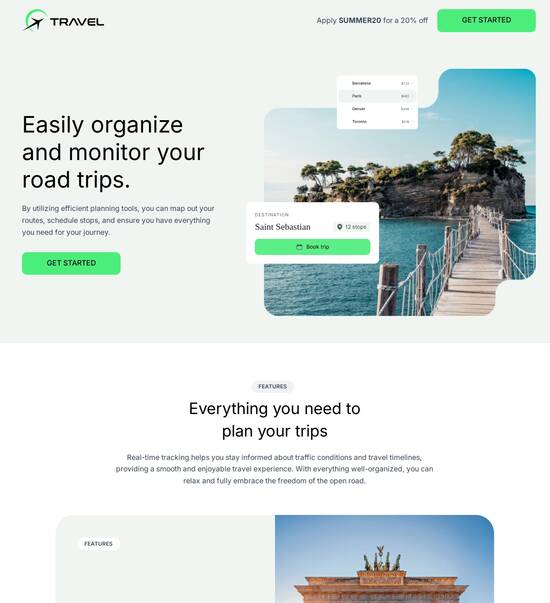
HTML page template for hardware stores
Use TemplateAbout template
Showcase your products with stunning landing page templates for your hardware stores. Ready to boost those sales?
Recommended templates

Easy to build without coding
With the intuitive drag-and-drop builder, anyone on your team can create high-converting pages without any knowledge of code or design. Make enhancements to your landing page with custom widgets using Javascript, HTML/CSS, or third-party scripts.

Multiple layouts for any industry and goal
Select from 500+ landing page layouts built to boost conversions across industry-specific scenarios. Customize them by adjusting fonts, adding images, and generating on-brand content with the AI assistant. Quickly scale with Instablocks® and Global Blocks that you can save, reuse, and update globally.

Loads fast and looks polished on any device
Every template is responsive, which means they present professionally on any device and load blazingly fast with our Thor Render Engine. You can also power them up with Google AMP technology to deliver an unparalleled mobile experience and drive higher conversions.

Robust analytics & experimentation
Get real-time updates and reporting across all your devices, showing the number of visitors, conversions, cost-per-visitor, and cost-per-lead. Launch AI-powered experiments, run A/B tests, and use heatmaps to analyze user behavior, then optimize your landing page to maximize conversions.







Easy to build without coding
With the intuitive drag-and-drop builder, anyone on your team can create high-converting pages without any knowledge of code or design. Make enhancements to your landing page with custom widgets using Javascript, HTML/CSS, or third-party scripts.
Multiple layouts for any industry and goal
Select from 500+ landing page layouts built to boost conversions across industry-specific scenarios. Customize them by adjusting fonts, adding images, and generating on-brand content with the AI assistant. Quickly scale with Instablocks® and Global Blocks that you can save, reuse, and update globally.
Loads fast and looks polished on any device
Every template is responsive, which means they present professionally on any device and load blazingly fast with our Thor Render Engine.
Robust analytics & experimentation
Get real-time updates and reporting across all your devices, showing the number of visitors, conversions, cost-per-visitor, and cost-per-lead. Launch AI-powered experiments, run A/B tests, and use heatmaps to analyze user behavior, then optimize your landing page to maximize conversions.
All the features you need to build hardware store marketing plan template
Explore more featuresLearn how to build hardware store website templates free
Frequently asked questions about hardware website templates free download
Leading the way in building high-performing landing pages





Design hardware templates: Your ultimate how-to guide
Instapage offers a powerful solution for marketers looking to create high-converting landing pages. With its extensive library of templates and advanced optimization features, Instapage ensures that businesses can tailor their campaigns to achieve maximum ROI. This guide provides a step-by-step process on utilizing Instapage for your landing pages, focusing on its capabilities that cater specifically to marketing departments across various sectors such as tech, education, and financial services.
Understanding the Instapage platform
Instapage is an all-in-one landing page and conversion rate optimization (CRO) platform designed for marketers. Its user-friendly interface and robust functionalities make it ideal for businesses of all sizes. Features such as drag-and-drop builders, built-in A/B testing, and detailed analytics empower teams to focus on their campaign strategies rather than grappling with technical issues.
- 100+ high-converting templates: With a wide selection of templates tailored to different business needs, marketers can quickly launch campaigns without starting from scratch.
- Built-in optimization tools: Instapage allows you to optimize your landing pages through A/B testing and detailed heatmap analysis, ensuring higher conversion rates.
- Collaboration features: Instapage enables seamless collaboration among team members and stakeholders with real-time editing and feedback options.
Step 1: Selecting the right template
Choosing the right template is crucial for the success of your landing page. Start by identifying your marketing goals and the specific audience you want to target. Instapage’s template library allows you to filter designs based on various criteria, making it easier to find what suits your campaign best.
- Identify campaign goals: Determine whether you want to generate leads, promote a product, or collect sign-ups.
- Consider your audience: Tailor your template choice based on the demographics and preferences of your target audience.
- Test variations: Use several templates for different target segments to assess which ones yield the best performance.
Step 2: Customizing landing pages
After selecting an appropriate template, personalize it to reflect your brand identity and messaging. Instapage's drag-and-drop editor simplifies the process, allowing you to modify text, images, and lead generation elements easily.
- Branding: Ensure your landing page carries your brand's colors, logos, and messaging to create a cohesive experience.
- Content relevance: Tailor the content on your landing page to directly address the pain points and interests of your audience.
- Call-to-action optimization: Clearly define your call-to-action (CTA) and strategically place it to prompt user engagement.
Step 3: Launching and optimizing performance
Once your page is ready, it's time to launch. Leverage Instapage's analytics dashboard to track your page's performance post-launch. Regularly monitor metrics like conversion rates and user engagement to continually optimize your landing pages.
By applying these steps, marketers can enhance their landing page strategies using Instapage’s dynamic features tailored for diverse industries. Remember, ongoing optimization is key to maintaining high conversion rates.
Ready to take your campaigns to the next level? Start using Instapage today and unlock the true potential of your digital marketing efforts!
HTML page template for hardware stores
The importance of a robust online presence for hardware stores
In an era where consumer preferences are rapidly shifting towards online shopping, hardware stores must recognize the significance of maintaining a strong online presence. Transaction patterns reveal that customers are increasingly seeking to browse and purchase products from the convenience of their homes. Thus, having a well-structured website is not merely an option but a necessity for enhancing local visibility and attracting a broader customer base.
Unlike other retail sectors, hardware stores face unique needs that require careful attention in website design. These stores often offer a vast array of products from tools and equipment to building supplies. Therefore, it’s vital for their websites to effectively showcase this diverse range without overwhelming potential buyers, allowing them to easily navigate and find what they’re looking for.
Core features of an effective hardware store website template
User-friendly navigation is fundamental for any online store, especially for hardware retailers. Customers typically look for specific tools or supplies, so structuring categories logically—like separating tools, equipment, and supplies—makes shopping a frictionless experience. Additionally, implementing a robust search function is crucial; if a customer can quickly find what they are looking for, they are more likely to complete a purchase.
An effective product display and information architecture further enhance user experience. High-quality images are essential as they capture consumer interest and can influence buying decisions. Detailed product descriptions that include specifications, uses, and price information are also vital. Incorporating customer reviews and ratings helps build trust and informs potential buyers, enhancing credibility and encouraging sales.
User-friendly navigation with categorized sections
High-quality images and detailed product descriptions
Integrated customer review and rating systems
Lastly, mobile responsiveness is an absolute must. With an increasing number of customers browsing and purchasing via their mobile devices, a hardware store's website must be designed to adapt seamlessly to various screen sizes. This adaptation not only improves customer experience but can directly impact sales, as customers tend to abandon sites that are difficult to use on their phones.
Optimizing for SEO: Enhancing visibility in searches
When developing an HTML page template for a hardware store, incorporating essential SEO elements is crucial for enhancing search visibility. This includes integrating meta tags and ensuring that alt descriptions for images are included. These elements play a critical role in how the website is indexed by search engines, making it more likely that potential customers will find the hardware store when searching for specific products.
Additionally, focusing on local SEO strategies is key, as hardware stores primarily serve local customers. Using location-based keywords can significantly improve search visibility within your community. Integrating Google My Business within the website template is another strategy that not only provides essential business information but also enhances local search rankings.
Integrate meta tags and alt descriptions for images
Focus on local SEO using location-based keywords
Leverage Google My Business integration for better local visibility
Marketing tools integrated into hardware store templates
Incorporating built-in analytics into a hardware store webpage helps track customer behavior and monitor website performance. With these insights, store owners can effectively adjust marketing strategies based on what is resonating with their audience. Monitoring metrics such as page views, click rates, and conversion rates is essential for fine-tuning promotional efforts.
Social media integration is another marketing tool that cannot be overlooked. By including links to various platforms, hardware stores can effectively engage with their customers and promote new products or sales. This kind of marketing strategy helps build a community around the brand and drives traffic back to the website, fostering customer loyalty.
Utilize built-in analytics for tracking performances
Incorporate social media links for deeper engagement
Crafting a compelling customer experience
Personalization features can significantly enhance a customer's online experience. Tailoring promotions based on customer behavior, such as their previous purchases or browsing habits, can make offers more appealing. Simple adjustments like greeting returning customers or suggesting items based on their last visit can lead to improved engagement and higher conversion rates.
Additionally, ensuring a seamless checkout process is imperative. A complicated checkout can lead to cart abandonment, a common occurrence in e-commerce. Streamlining checkout options with various payment gateways provides flexibility and security for buyers, encouraging them to complete their purchases.
Implement personalization features for better engagement
Ensure a seamless checkout process to reduce cart abandonment
The role of design in attracting customers
The aesthetic appeal of a website is vital in enticing customers. Selecting the right color schemes and fonts can enhance brand recognition, ensuring your website aligns with your hardware store's identity. It's essential to choose designs that prioritize readability and accessibility, as a cluttered site can lead to customer frustration and potential disengagement.
Furthermore, adhering to layout best practices is essential for effectively showcasing promotions and seasonal items. Streamlining page layouts that highlight specific products while utilizing adequate white space can guide customer focus toward what matters. An organized look that is easy to navigate will keep customers returning to your site.
Select aesthetically appealing color schemes and fonts
Adhere to layout best practices for product visibility
Leveraging tools for enhanced web design
When building a website for a hardware store, it’s crucial to explore available website builders. Various platforms offer unique features suitable for hardware retail, such as ease of use, drag-and-drop capabilities, and customizable templates. These tools can greatly simplify the website creation process, allowing store owners to focus on selecting the right products rather than getting bogged down in technical details.
Features like pre-built sections can expedite the design process, making it easier to create engaging pages without extensive coding knowledge. This capability allows hardware stores to quickly customize their pages to stray ahead of competitors while still delivering a professional appearance.
Explore user-friendly website builders with essential features
Utilize drag-and-drop functionality for quick design
Addressing customer queries with efficiency
Implementing an effective FAQs section is invaluable for reducing customer service workload. Including answers to common questions related to the tools and equipment sold can preempt potential inquiries, ensuring customers have access to immediate information. This not only streamlines the shopping process but also enhances overall customer satisfaction.
Furthermore, integrating live chat support allows customers to receive on-the-spot assistance. Whether they have questions about specific tools or need guidance on making a purchase, live chat can direct customers to relevant products. This responsiveness makes the shopping experience much smoother, potentially leading to increased sales.
Include an FAQs section to address common inquiries
Integrate live chat for real-time customer support
Future trends in hardware store web design
The evolution of e-commerce within the hardware market is closely tied to advancements in technology; thus, we can predict changes that will affect how customers interact with hardware store websites. Being able to adapt to technological breakthroughs and shifting consumer preferences will be instrumental for hardware stores seeking to thrive online. Expect future websites to offer more personalized experiences through smarter algorithms.
Emerging tools like augmented reality (AR) can offer customers the ability to visualize products in their own spaces before purchasing, thereby enhancing engagement. Interactive designs will likely play a more prominent role in keeping consumers interested and informed, making it vital for hardware store websites to explore how they can implement these innovative features.
Adapt to technological advancements shaping e-commerce
Explore AR and interactive designs to boost engagement
Tips for successful implementation of the template
Once you've decided on an HTML page template for your hardware store, adhering to best practices for customization is essential. This involves recognizing common design pitfalls that many retailers encounter. For example, maintaining current website security measures and regularly updating content are crucial for both SEO and customer trust.
Establishing a routine for performance monitoring should not be overlooked. Utilizing analytics tools can provide necessary insights into how the website is performing regarding traffic and conversions. This data allows hardware stores to adapt their marketing strategies efficiently, ensuring they attract and retain their target audience.
Follow best practices for customizing the template
Establish a routine for performance monitoring and updates
Ready to skyrocket conversions?
Supercharge your ad campaigns with high-performing landing pages
Get started














